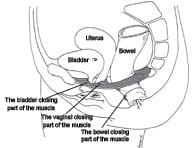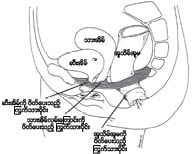| When you are pregnant, you get a lot of advice from many people. One topic few people think about is bladder and bowel control problems during pregnancy and after the birth. | သင္ ကိုယ္ဝန္ရွိေနသည့္အခါ၌ သင္သည္ လူမ်ားစြာထံမွ အႀကံဉာဏ္မ်ားစြာရရွိတတ္ပါသည္။ လူအနည္းအက်ဥ္းသာ ကိုယ္ဝန္လြယ္ေနစဥ္အေတာအတြင္းႏွင့္ မီးဖြားၿပီးေနာက္ပိုင္း၌ ျဖစ္တတ္ေသာ ဆီးႏွင့္ ဝမ္း ခ်ဳပ္ထိန္းမႈဆိုင္ရာ ျပႆနာမ်ားအေၾကာင္းကို စဥ္းစားေတြးေတာၾကပါသည္။ |
How do I know if i have a problem?There are a few things that might happen if you have weak pelvic floor muscles. You might:
Pelvic organ prolapse Without good support one or more of your pelvic organs might sag down into your vagina. This is called pelvic organ prolapse. Prolapse is very common. It happens to about 1 in 10 women in Australia. Women feel a heaviness, or a bulge or dragging in the vagina. Across the lifespan, 1 in 5 women may require surgery if these symptoms are a bother. Sexual problems You may also have sexual problems. After the birth, you will be very tired and busy with your baby. Vaginal birth can cause weakness around the vagina. The vagina may lack feeling. Vaginal tears and trauma can cause pain for many months. While breast feeding, hormones can make the vagina dry. This can cause more problems. Talk with a health professional about these things if they are a problem. | ကၽြႏု္ပ္၌ ဒုကၡရွိ၊ မရွိ ကၽြႏု္ပ္ မည္ကဲ့သို႔ သိမည္နည္း။သင့္၌ အားနည္းေသာ တင္ပါးဆုံခြက္ႂကြြက္သားမ်ားရွိလွ်င္၊ ျဖစ္ဖြယ္ႏိုင္ရာကိစၥမ်ားအခ်ဳိ႕ရွိပါသည္။ သင့္၌ ျဖစ္ေကာင္းျဖစ္ႏိုင္သည္မ်ားမွာ
တင္ပါးဆုံ ကိုယ္အဂၤါအစိတ္အပိုင္း ေလွ်ာက်မႈ ထိန္းခံေပးႏိုင္မႈ မေကာင္းလွ်င္၊ သင့္ တင္ပါးဆုံ ကိုယ္အဂၤါအစိတ္အပိုင္း တစ္ခု သို႔မဟုတ္ တစ္ခုထက္မက သင့္ သားအိမ္လမ္းေၾကာင္းထဲသို႔ ညြတ္က်လာႏိုင္ဖြယ္ရွိပါသည္။ ၎ကို တင္ပါးဆုံ ကိုယ္အဂၤါအစိတ္အပိုင္း ေလွ်ာက်မႈဟုေခၚပါသည္။ ေလွ်ာက်မႈသည္ ျဖစ္႐ိုးျဖစ္စဥ္တစ္ခုျဖစ္ပါသည္။ ၾသစေၾတးလ်ားႏိုင္ငံတြင္ အမ်ဳိးသမီး ၁၀ ဦး အနက္ ၁ ဦးခန္႔ျဖစ္တတ္ပါသည္။ အမ်ဳိးသမီးမ်ားသည္ သားအိမ္လမ္းေၾကာင္းထဲတြင္ တစ္ခုခု ေလးလံေနသည္၊ သို႔မဟုတ္ စူထြက္ေနသည္ သို႔မဟုတ္ တရြတ္တိုက္ဆြဲေနသည္ဟု ခံစားရပါမည္။ အကယ္၍ ဤေရာဂါလကၡဏာမ်ား ဒုကၡေပးေနလွ်င္ အမ်ဳိးသမီး ၅ ဦး အနက္ ၁ ဦးသည္ သူတို႔သက္တမ္းတစ္ေလွ်ာက္၌ ခြဲစိတ္ကုသရန္ လိုအပ္ေကာင္းလိုအပ္ပါလိမ့္မည္။ လိင္ပိုင္းဆိုင္ရာ ျပႆနာအခက္အခဲမ်ား သင့္၌ လိင္ပိုင္းဆိုင္ရာ ျပႆနာအခက္အခဲမ်ားလည္း ျဖစ္ႏိုင္ဖြယ္ရွိပါသည္။ မီးဖြားၿပီးေနာက္၊ သင္သည္ အလြန္ပင္ပန္းေနၿပီး ကေလးႏွင့္ အလုပ္႐ႈပ္ေနပါလိမ့္မည္။ သားအိမ္လမ္းေၾကာင္းမ် မီးဖြားလွ်င္ သားအိမ္လမ္းေၾကာင္းအနီးတစ္ဝိုက္ အားေလ်ာ့နည္းေစပါသည္။ သားအိမ္လမ္းေၾကာင္း၌ ခံစားမႈ ေလ်ာ့နည္းႏိုင္ဖြယ္ရွိပါသည္။ သားအိမ္လမ္းေၾကာင္းဆိုင္ရာ စုတ္ၿပဲမႈမ်ားႏွင့္ ဒဏ္ျဖစ္မႈသည္ လေပါင္းမ်ားစြာအတြက္ နာက်င္ေနေစႏိုင္ပါသည္။ ကေလးႏို႔တိုက္ေနေသာအခါ၌ ေဟာ္မုန္းဓာတ္မ်ားက သားအိမ္လမ္းေၾကာင္းကို ေျခာက္ေသြ႕ေစႏိုင္ပါသည္။ ၎တို႔သည္ ျပႆနာမ်ားကို ပိုတိုးလာႏိုင္ေစပါသည္။ ဤကိစၥမ်ားသည္ ဒုကၡေပးေနလွ်င္ ဤအေၾကာင္းမ်ားကို က်န္းမာေရးပညာရွင္ႏွင့္ ေဆြးေႏြးတိုင္ပင္ပါ။ |
Am I likely to get bladder and bowel problems?Some women seem more likely to have bladder and bowel problems than others. Even women who have quite an easy birth can have problems. We can’t always tell which women are likely to have problems. If a woman has bladder or bowel problems, such as irritable bowel syndrome or an urgent need to pass urine (overactive bladder) before pregnancy, these are likely to get worse after birth. Women can also get new bladder or bowel problems after giving birth. Constipation, coughing and obesity can make things worse. Certain things about the birth can make bladder and bowel problems more likely such as having:
| ကၽြႏု္ပ္၌ ဆီးအိမ္ႏွင့္ ဝမ္းပိုင္းဆိုင္ရာ ဒုကၡ ျဖစ္ႏုိ္င္ဖြယ္ရွိသလား။အခ်ဳိ႕အမ်ဳိးသမီးမ်ားသည္ အျခားသူမ်ားထက္စာလွ်င္ ဆီးႏွင့္ ဝမ္းပိုင္းဆိုင္ရာ ဒုကၡမ်ား ပိုၿပီးရွိႏိုင္ျခင္းကိုေတြ႕ရပါသည္။ အလြန္ လြယ္လြယ္ကူကူ မီးဖြားခဲ့ၾကေသာ အမ်ဳိးသမီးမ်ားပင္ ဒုကၡမ်ားရွိနိုင္ပါသည္။ မည္သည့္္အမ်ဳိးသမီးမ်ား၌ ဒုကၡမ်ားျဖစ္ႏိုင္ဖြယ္ရွိျခင္းကို ကၽြႏု္ပ္တို႔ တပ္အပ္မေျပာႏိုင္ပါ။ အမ်ဳိးသမီးတစ္ဦးဆီ၌ ကိုယ္ဝန္မတည္မီ irritable bowel syndrome (မအီမသာျဖစ္ေစေသာ ဝမ္းပိုင္းဆိုင္ရာ ေရာဂါလကၡဏာစု) ကဲ့သို႔ေသာဒုကၡ၊ သို႔မဟုတ္ (လိုအပ္သည္ထက္ ပိုအလုပ္လုပ္ေနေသာ ဆီးအိမ္ဟုေခၚႏိုင္သည့္) ဆီးသြားရန္ အေရးတႀကီးလိုအပ္သကဲ့သို႔ေသာဒုကၡ၊ ဆီးအိမ္ သို႔မဟုတ္ ဝမ္းပိုင္းဆိုင္ရာ ဒုကၡ၊ ဤဒုကၡမ်ားရွိလွ်င္၊ ၎တို႔သည္ မီးဖြားၿပီးေနာက္ပိုင္း ပိုဆိုးလာႏိုင္ဖြယ္ရွိပါသည္။ အမ်ဳိးသမီးမ်ား၌ မီးဖြားၿပီးေနာက္ပိုင္း ဆီး သို႔မဟုတ္ ဝမ္းဆိုင္ရာ ျပႆနာအသစ္မ်ားလည္းျဖစ္ႏိုင္ပါသည္။ ဝမ္းခ်ဳပ္လွ်င္၊ ေခ်ာင္းဆိုးလွ်င္၊ ဝလြန္းလွ်င္ အေျခအေနမ်ားကို ပိုဆိုးေစႏိုင္ပါသည္။ ေအာက္ပါမ်ားကဲ့သို႔ မီးဖြားျခင္းႏွင့္ ပတ္သက္ရာ အေၾကာင္းကိစၥအခ်ဳိ႕မ်ား၌ ဆီး ႏွင့္ ဝမ္းဆိုင္ရာ ဒုကၡမ်ားကို ပိုျဖစ္ေစႏိုင္ဖြယ္ရွိပါသည္။
|
What if I have a caesarean birth?Choosing a caesarean birth might seem like a way to avoid these problems, but it is not that simple. A caesarean birth might reduce the risk of severe bladder control problems from 10% to 5% for a first baby. But after the third caesarean birth there may be no benefit at all. Caesarean births carry their own risks. Babies born this way are more likely to have breathing problems at birth. It can also be more risky for the mother. Scarring from caesarean births can make future pelvic surgery more difficult. So you may be trading one problem for another. In many cases, a vaginal birth runs just as planned and is a lovely event for parents. This type of birth is best when possible. However problems can still happen. We are still learning how we might prevent damage to the pelvic floor during birth. For now, pregnancy and birth mean making a choice between different risks. You and your partner need to think about these risks. You need to discuss them with your pregnancy care professional. | ကၽြႏု္ပ္ ဗို္က္ခြဲေမြးရလွ်င္ေကာ။ဗိုက္ခြဲေမြးရန္ ေရြးခ်ယ္လွ်င္ ဤျပႆနာမ်ားကို ေရွာင္ကြင္းသည့္ နည္းတစ္နည္းျဖစ္လိမ့္မည္ဟု ထင္ရေသာ္လည္း ထင္သကဲ့သို႔ မလြယ္ပါ။ ဗိုက္ခြဲေမြးလွ်င္ ျပင္းထန္ဆိုးရြားေသာ ဆီးခ်ဳပ္ထိန္းမႈျပႆနာမ်ား ျဖစ္ေပၚလိမ့္မည့္အလားအလာကို ပထမ ကေလး၌ဆိုလွ်င္ ၁၀% မွ ၁၅% အထိ ေလ်ာ့နည္းေစေကာင္း ေလ်ာ့နည္းေစႏိုင္ေသာ္လည္း၊ တတိယအေခါက္ ဗိုက္ခြဲေမြးသည့္အခါ၌ အက်ဳိးလုံးဝမရွိႏိုင္ေတာ့ပါ။ ဗိုက္ခြဲေမြးလွ်င္ ခြဲေမြးျခင္းႏွင့္ သက္ဆိုင္သည့္ အႏၲရာယ္သက္သက္မ်ားရွိပါသည္။ ဤနည္းႏွင့္ ေမြးေသာကေလးမ်ားသည္ ေမြးဖြားခ်ိန္၌ အသက္႐ႈျခင္းဆိုင္ရာ ျပႆနာမ်ား ပိုၿပီးရွိႏိုင္သကဲ့သို႔ မိခင္အတြက္လည္း ပိုၿပီးအႏၲရာယ္ရွိႏိုင္ပါသည္။ ဗိုက္ခြဲေမြးသည့္အတြက္ ျဖစ္လာေသာ ဒဏ္ရာဒဏ္ခ်က္မ်ားသည္ အနာဂတ္၌ လိုအပ္လာလွ်င္ တင္ပါးဆံုကို ခြဲစိတ္ကုသရန္ ပိုၿပီးခက္ခဲေစႏိုင္ပါသည္။ ၎ေၾကာင့္ ျပႆနာတစ္ခုကို ေနာက္တစ္ခုႏွင့္ အစားထိုးသကဲ့သို႔ ျဖစ္သြားႏိုင္ပါသည္။ အေျခအေနအမ်ားစုတြင္ သားေမြးလမ္းေၾကာင္းမွ မီးဖြားျခင္းသည္ စီစဥ္ထားသည့္အတိုင္းပင္ ျဖစ္ေလ့ရွိၿပီး မိဘမ်ားအတြက္ ၾကည္ႏူးစရာအျဖစ္အပ်က္တစ္ခုျဖစ္ပါသည္။ ဤသို႔ျဖစ္ႏိုင္လွ်င္ ၎မွာ အေကာင္းဆံုး ေမြးဖြားနည္းပင္ျဖစ္ပါသည္။ သို႔ေသာ္လည္း ျပႆနာမ်ားကား ျဖစ္ႏိုင္ဆဲျဖစ္ပါသည္။ မီးဖြားခိုက္ တင္ပါးဆံုခြက္ ထိခိုက္ပ်က္စီးမႈ မျဖစ္ရန္္ မည္ကဲ့သို႔ ေရွာင္ရွားရမည္ကို ကၽြႏု္ပ္တို႔ ေလ့လာေနဆဲျဖစ္ပါသည္။ ေလာေလာဆယ္၌ ကိုယ္ဝန္ေဆာင္ရာ၌ႏွင့္ မီးဖြားရာ၌ အႏၲရာယ္မ်ဳိးစုံ ေရွ႕ေမွာက္ရွိေနသည့္အနက္ အေကာင္းဆံုးအေျခအေနကို ရယူရန္ပင္ျဖစ္ပါသည္။ သင္ႏွင့္ သင့္ၾကင္ေဖာ္ၾကင္ဖက္တို႔သည္ ဤအႏၲရာယ္မ်ားအေၾကာင္းကို စဥ္းစားထားရန္လိုပါသည္။ သင္သည္ သင္၏ မီးဖြားျခင္းဆိုင္ရာ ျပဳစုေစာင့္ေရွာက္ေရး အတတ္ပညာရွင္ႏွင့္ ေဆြးေႏြးရန္လိုအပ္ပါသည္။ |
What do my pelvic floor muscles do?Look at the picture of the pelvic floor. The pelvic floor muscles do a few things. They help to:
| ကၽြႏု္ပ္၏ တင္ပါးဆုံခြက္ႂကြြက္သားမ်ားက မည္သည့္အရာမ်ားကို လုပ္ေပးသနည္း။တင္ပါးဆုံခြက္၏ ပံုကိုၾကည့္ပါ။ တင္ပါးဆုံခြက္ႂကြြက္သားမ်ား၌ လုပ္ငန္းတာဝန္မ်ားအခ်ဳိ႕ရွိၿပီး၊ ေအာက္ပါတို႔ကို အေထာက္အကူျပဳပါသည္။
|
What can I do about weak pelvic floor muscles?The birth of a baby might have stretched your pelvic floor muscles. Any ‘pushing down’ actions the first weeks after the birth might stretch the pelvic floor muscles again. Avoid ‘pushing down’ actions in the first weeks after the birth. This will protect them. Here are a few ideas to help you.
For more information, see ‘Good Bladder Habits for Everyone’ and ‘Pelvic Floor Muscle Training for Women’. | အားနည္းေနေသာ တင္ပါးဆုံခြက္ႂကြြက္သားမ်ားႏွင့္ပတ္သက္ၿပီး ကၽြႏု္ပ္ ဘာလုပ္ႏိုင္သနည္း။ကေလးေမြးသည့္အတြက္ သင့္ တင္ပါးဆုံခြက္ႂကြြက္သားမ်ား ဆန္႔က်ယ္သြားႏိုင္ဖြယ္ရွိပါသည္။ မီးဖြားၿပီးေနာက္ ပထမအပတ္မ်ား၌ ေအာက္ကို ဖိခ်ေပးေသာ မည္သည့္လႈပ္ရွားမႈမ်ဳိးမဆို တင္ပါးဆုံခြက္ႂကြြက္သားမ်ားကို ထပ္မံၿပီး ဆန္႔က်ယ္သြားေစႏိုင္ပါသည္။ မီးဖြားၿပီးေနာက္ ပထမအပတ္မ်ား၌ သင္၏ တင္ပါးဆုံခြက္ႂကြြက္သားမ်ား ေအာက္သို႔ ဖိခ်ျခင္းမ်ားကို ေရွာင္ရွားပါ။ ၎သည္ ႂကြြက္သားမ်ားကို ကာကြယ္ေပးပါလိမ့္မည္။ ေအာက္ပါအႀကံဉာဏ္အခ်ဳိ႕သည္ သင့္အား အေထာက္အကူျပဳရန္အတြက္ျဖစ္ပါသည္။
ေနာက္ထပ္အခ်က္အလက္မ်ားအတြက္ (လူတိုင္းအတြက္ ဆီးသြားျခင္းဆိုင္ရာ အေလ့အက်င့္ေကာင္းမ်ား) ႏွင့္ (အမ်ဳိးသမီးမ်ားအတြက္ တင္ပါးဆုံခြက္ႂကြြက္သားမ်ား ေလ့က်င့္ခန္း) ၌ ၾကည့္ပါ။ |
Will things get better?Do not lose heart. In the first six months after giving birth, bladder or bowel control may get better without help. Even if the bladder or bowel problem seems severe, the pelvic floor tissues, muscles and nerves can mend with time. Regular pelvic floor muscle training kept up over the long term, as well as the right advice, will help. Don’t forget to look after yourself. At this time it is easy to neglect your own needs. Seek help if things are not getting better after six months. Speak to your doctor, continence physiotherapist or continence nurse advisor. | အေျခအေနမ်ား တိုးတက္လာပါမည္လား။စိတ္မပ်က္ပါႏွင့္။ မီးဖြားၿပီးေနာက္ ပထမ ေျခာက္လအတြင္း၌ ဆီးႏွင့္ဝမ္း ခ်ဳပ္ထိန္းႏိုင္မႈသည္ ၎အလိုအေလ်ာက္ ေကာင္းလာႏိုင္ဖြယ္ရွိပါသည္။ ဆီးႏွင့္ဝမ္းဆိုင္ရာ ျပႆနာမ်ားသည္ ဆိုးရြားလွသည္ဟု ထင္ရလွ်င္ပင္ တင္ပါးဆုံခြက္ အသားမွ်င္မ်ား၊ ႂကြြက္သားမ်ားႏွင့္ အာ႐ံုေၾကာမ်ားသည္ အခ်ိန္ၾကာလာသည္ႏွင့္အမွ် ျပန္လည္ေကာင္းမြန္လာႏိုင္ပါသည္။ ေရရွည္ကာလအတြက္ တင္ပါးဆုံခြက္ႂကြြက္သားဆိုင္ရာ ပုံမွန္ေလ့က်င့္ခန္းလုပ္ျခင္းမ်ားႏွင့္ သင့္ေလ်ာ္မွန္ကန္သည့္ အႀကံဉာဏ္မ်ားရယူျခင္းတို႔သည္ အေထာက္အကူျဖစ္ပါလိမ့္မည္။ မိမိကိုယ္မိမိ ဂ႐ုစိုက္ၾကည့္႐ႈရန္ မေမ့ပါႏွင့္။ ဤသို႔ေသာ အခ်ိန္မ်ဳိး၌ သင့္ကိုယ္ပိုင္ လိုအပ္ခ်က္မ်ားကို အေရးမထားမိဘဲ လစ္ဟင္းႏိုင္လြယ္ပါသည္။ ၆ လ ၾကာျမင့္ၿပီးေနာက္ အေျခအေနမ်ားမွာ မတိုးတက္လာလွ်င္ အကူအညီေတာင္းပါ။ သင့္ ဆရာဝန္၊ ဆီး/ဝမ္း ထိန္းႏိုင္မႈဆိုင္ရာ ပညာရွင္ (ဖီဆီယို) သို႔မဟုတ္ ဆီး/ဝမ္း ထိန္းႏိုင္မႈဆိုင္ရာ သူနာျပဳ အႀကံေပးႏွင့္ေတြ႕ပါ။ |
Seek helpYou are not alone. Poor bladder and bowel control can be cured or better managed with the right treatment. If you do nothing, it might get worse. Phone expert advisors on the National Continence Helpline for free:
1800 33 00 66 * (8am - 8pm Monday to Friday AEST) * Calls from mobile telephones are charged at applicable rates. To arrange for an interpreter through the Telephone Interpreter Service (TIS), phone 13 14 50 Monday to Friday and ask for the National Continence Helpline. Information in other languages is also available from continence.org.au/other-languages For more information:
* Calls from mobiles are charged at applicable rates. | အကူအညီ ရယူပါသင္ တစ္ဦးတည္း ျဖစ္ေနျခင္း မဟုတ္ပါ။ ဆီးႏွင့္ ဝမ္း ခ်ဳပ္ထိန္းထားႏိုင္ရန္ အားေလ်ာ့နည္းမႈကို ကုသႏိုင္ပါသည္ သို႔မဟုတ္ သင့္ေလ်ာ္ေသာ ကုသနည္းျဖင့္ ပိုမိုေကာင္းမြန္စြာ ကိုင္တြယ္စီမံေပးႏိုင္ပါသည္။ အကယ္၍ သင္ မည္သို႔မွ် မလုပ္ဘဲေနမည္ဆိုပါက အေျခအေန ပိုဆိုးလာႏိုင္ဖြယ္ရွိပါသည္။ National Continence Helpline (တစ္ျပည္လံုးဆိုင္ရာ ဆီး/ဝမ္း ထိန္းႏိုင္မႈဆိုင္ရာ ကူညီေရးဖုန္းလိုင္း) မွ ကၽြမ္းက်င္သူ အႀကံေပးမ်ားကို ေအာက္ပါကိစၥမ်ားအတြက္ အခမဲ့ဖုန္းဆက္ပါ။
1800 33 00 66 * (တနလၤာေန႔မွ ေသာၾကာေန႔၊ မနက္ ၈ နာရီမွ ည ၈ နာရီ ၾသစေၾတးလ်ားႏိုင္ငံေတာ္ အေရွ႕ပိုင္းေဒသ စံေတာ္ခ်ိန္) TIS (တယ္လီဖုန္း စကားျပန္ ဝန္ေဆာင္မႈ) မွတဆင့္ စကားျပန္တစ္ဦးကို စီစဥ္ရန္ တနလၤာေန႔မွ ေသာၾကာေန႔အတြင္း 13 14 50 ကို ဆက္ၿပီး National Continence Helpline (တစ္ျပည္လံုးဆိုင္ရာ ဆီး/ဝမ္း ထိန္းႏိုင္မႈဆိုင္ရာ ကူညီေရးဖုန္းလိုင္း) ကို ေတာင္းပါ။ အခ်က္အလက္မ်ားကို အျခားဘာသာစကားမ်ားျဖင့္လည္း continence.org.au/other-languages တြင္ ရရွိႏိုင္ပါသည္။ ေနာက္ထပ္အခ်က္အလက္မ်ားအတြက္ ေအာက္တြင္ ၾကည့္ပါ။
* မိုဘိုင္းဖုန္းႏွင့္ ဆက္ေခၚပါက သက္ဆိုင္ရာ အဖိုးအခႏႈန္းအတိုင္း ေတာင္းခံပါလိမ့္မည္။ |
Expecting A Baby? in Burmese
ကိုယ္ဝန္ရွိေနသလား။
Browse and download our factsheets in Burmese
Last Updated: Fri 02, Jun 2023
Last Reviewed: Tue 17, Mar 2020



